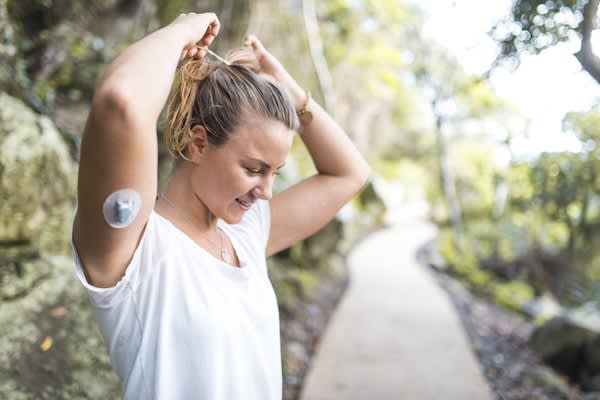Living and thriving with diabetes

[4 MIN READ]
In this article:
-
While there is no way to prevent Type 1 diabetes, there are new therapies that can delay its progression if you catch it in the early stages.
-
The best way to reduce your risk for Type 2 diabetes is to make self-care a priority.
-
Learn some tips for how to manage your diabetes better.
Living with diabetes: Your guide to a healthy life
According to the Centers for Disease Control and Prevention, 38.4 million people in the United States are living with diabetes. That means 11.6% of the U.S. population has to regularly monitor blood sugar levels, often using insulin to control the amount of sugar in the blood.
November is American Diabetes Month, which means it’s a perfect time to take a look at the best ways to live well with diabetes.
The difference between Type 1 and Type 2 diabetes
First, let’s take a look at what diabetes is, and how it affects a person. In both types of diabetes, a person’s blood sugar levels can become too high because the body doesn’t produce insulin or use it properly. However, Type 1 and Type 2 diabetes have very different causes and potential complications.
Type 1 diabetes
Type 1 is a genetic disorder in which the pancreas makes little or no insulin. Insulin helps blood sugar enter the body’s cells to be used as energy. Without insulin, blood sugar builds up in the bloodstream, causing complications such as:
- Heart disease
- Nerve damage
- Foot damage
- Eye problems
- Kidney damage
- Pregnancy complications
People with Type 1 diabetes must keep careful track of their blood sugar levels — otherwise, they run the risk of hypoglycemia (low blood sugar) or hyperglycemia (high blood sugar). This disease is often diagnosed in childhood, which is why it used to be called juvenile diabetes.
“Currently, there aren’t ways of completely preventing it, but there are new therapies that can delay the progression if Type 1 diabetes is caught in very early stages — typically before there are symptoms,” says Caitlin Snider, MS, RDN, CDCES, a diabetes health educator with Providence. “People with a parent or sibling with Type 1 diabetes, and people with other autoimmune conditions like celiac or Hashimoto’s diseases, are at a higher risk. If you think you may be at an increased risk for Type 1 diabetes, talk to your doctor about screening tests or look into joining a prevention study through TrialNet.”
Type 2 diabetes
Unlike Type 1 diabetes, which often appears in childhood, Type 2 diabetes is most likely to be diagnosed in middle-aged or older adults. About 90-95% of people with diabetes have type 2, in which your pancreas makes some insulin but your cells don’t respond to it as they should.
Type 2 diabetes is caused by an underlying genetic predisposition, and factors like weight, activity level and eating habits can increase the chances that people with that predisposition will end up with diabetes.
“The best way to reduce your risk is to make self-care and your overall health a top priority,” says Snider. “Make time for regular exercise — at least 150 minutes per week is recommended. Cook and eat balanced meals with lots of fruits and vegetables, get enough sleep and find stress relief. If this all sounds like a lot, pick one healthy habit to start with. If you think you’re at risk for Type 2 diabetes, talk to your doctor about getting tested.”
Healthy habits for managing diabetes
For any person with either Type 1 or Type 2 diabetes, daily management is key. Keep a close eye on your blood sugar levels, watch what you eat and monitor your body for any big changes.
“If you have diabetes and would like to manage it better, ask your doctor for a referral to a diabetes care and education specialist [DCES],” says Snider. “Our job is to help people learn how to live their best lives with diabetes. Studies show that people who work with a DCES have lower A1c levels and a lower risk for complications. Managing diabetes is best done through a holistic approach that involves lifestyle changes.”
If you manage your diabetes well, you’ll be able to live a normal life — including playing sports, if you wish. “People who use insulin or a few other medications are at an increased risk of low blood sugar. This can be extremely dangerous if not treated right away,” says Snider. “Eating enough carbohydrates before and during activities like sports or driving can prevent low blood sugar. New diabetes technology, like continuous glucose monitors, can alert you if your blood sugar is getting too low so you can treat it right away.”
Diabetes management at Providence
At Providence, our doctors, nurses and dietitians want to help you manage this chronic condition, develop a treatment plan and live a healthy life. We offer diabetes management programs with topics such as:
- Diabetes medication management
- Blood glucose level monitoring instruction
- Insulin administration
- Lifestyle adjustments
- Healthy coping with diabetic stress
- Diabetes care and management before and during pregnancy
- Healthy eating with nutrition guidance, meal planning and weight management
- Preventive education for patients with pre-diabetes in order to prevent or delay diabetes
- Resources for community outreach programs
Learn more about diabetes care at Providence.
Contributing caregivers
Caitlin Snider, MS, RDN, CDCES, is a diabetes health educator with Providence.
Find a doctor
If you are looking for a Providence primary care provider, you can search for one in our provider directory.
Download the Providence app
It’s all in the app: easily stay connected with Providence and your health. With the Providence app, you can schedule appointments, have virtual visits from the comfort of your own home, get health recommendations personalized for you, access your health records and so much more. Learn more and download the app.
Related resources
Healthy eating tips for older adults
Debunking common myths about diabetes
Losing weight to gain a new life
Culture of Health podcast: Diabetes
This information is not intended as a substitute for professional medical care. Always follow your health care professional’s instructions.


